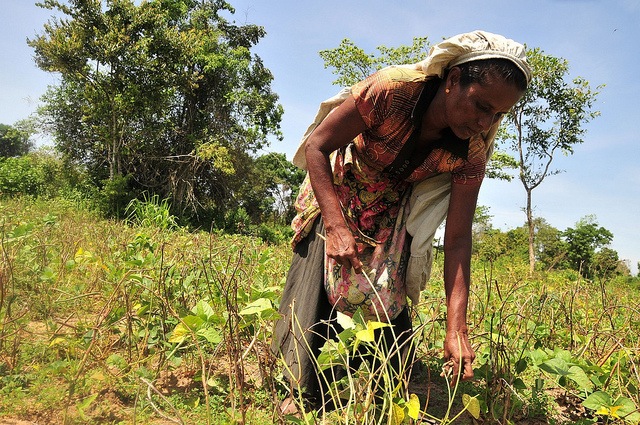By Amantha Perera
COLOMBO, Jun 5, 2012 (IPS) – When it comes to expressing the threat to food security posed by changing climate patterns and extreme weather events in Asia and the Pacific, the Asian Development Bank (ADB) does not mince its words.

Woman works in family garden in her village of Pillumallai in eastern Sri Lanka. Credit: Amantha Perera/IPS
“The greatest threat to food security is climate change,” the Bank said in a 45-page report, âFood Security and Poverty in Asia and the Pacific: Key Challenges and Policy Issuesâ, released late last month.
The reportâs findings ring especially true in Sri Lanka, where experts are increasingly expressing concerns about the twin crises of food security and global warming.
The ADB study looked at areas that could affect food security, such as trade policies, development, the demand for food and resource management and possible mitigation efforts. It tagged climate change as a key player in determining food security levels, as interventions needed to stem the impacts of global warming go beyond national borders and surpass the authority of any single government.
“Problems caused by climate change are much more difficult to resolve in the short term and will require long-term and internationally coordinated solutions,” it said.
Sri Lankan climate change expert Riza Yehiya, an architect and sustainability consultant, echoed the ADBâs sentiments.
“The issues of climate change and food security in Sri Lanka are becoming alarming,” he told IPS, adding that changing climate patterns combined with a lack of proper policies to mitigate adverse impact have put the South Asian island in a precarious position.
Though Sri Lanka is yet to experience protracted and deadly food shortages due to changing weather patterns, recent experiences have shown that its vital rice harvest does fluctuate wildly depending on rainfall.
In 2011, close to 20 percent of the harvest was wiped out when devastating floods between January and February were followed by a harsh drought in some flood-hit areas.
The worst affected populations of these twin crises struggled hard to make ends meet. United Nationsâ updates on the impact of floods on the East coast detailed instances of older children dropping out of school in order to help their families who, as a result of a ruined harvest, had lost their only source of income.
“Too much rain or too little (ruins) any crop, not only paddy. Rainfall fluctuation, especially in 2011, left crops vulnerable,” Malika Wimalasuriya, head of the climate change unit at the Meteorological Department, told IPS.
“Sri Lanka, being closer to the equator, is more vulnerable to climate change impacts (than other countries),” Yehiya warned. In fact, the ADB report predicted large crop losses in Asia due to changing climate patterns in the next 100 years primarily due to its proximity to the equator.
“Yield losses are expected to be even larger (than the Pacific) in tropical regions such as South and Southeast Asia, and will continue to drop further toward 2100. In Southeast Asia, the rice yield is projected to fall by about 50 percent in 2100 relative to 1990 yields,” according to the study.
Officials at the climate change unit of the Meteorological Department highlighted that severe water scarcity is also a very real possibility for the Sri Lankan agriculture sector in the future, especially since rising temperatures will exacerbate decreasing rainfall.
Yehiya pointed out that overuse of fertiliser has made the land less productive while the demand for food is likely to rise in the future, putting even more pressure on producers.
“One of the biggest problems with Sri Lankan agriculture is the lack of water management,” observed Mudalihamige Rathnayake, head of the Department of Geography at the southern Ruhunu University.
He told IPS that Sri Lankan farmers still rely heavily on the Irrigation Department to release water from reservoirs, rather than taking the initiative on water management themselves.
“We still do not have a culture where farmers feel they have to manage their own water resources,” he lamented.
“Sri Lanka has been identified as one of the worldâs future water deficit countries,” Yehiya remarked. “This deficit is not (only) due to the inadequacy of water resources but due to the lack of efficient water resource management, policies and programmes.”
As ground water supplies dry up, the threat of rising salinity emerges as yet another obstacle to food production and security.
Some of the island’s largest rice producing areas in the Digamadulla, Batticaloa and Trincomalee districts along the eastern coast lie very close to the sea, heightening the risk of seawater intrusion due to rising sea levels.
Officials at the Coast Conservation Department (CCD) told IPS that Sri Lanka’s western and eastern coasts were susceptible to erosion with some areas showing annual erosion levels of five metres. CCD Director Anil Premarathne told IPS that wave height and intensity rose during the monsoon season, which has become shorter but more extreme.
“Even a small rise in the sea level could increase the salinity in groundwater. You may not see seawater intrusion on the surface, but salinity levels will change below the ground,” he said.
The CCD official also noted the difficulty of implementing a clear policy on countering erosion, making the coast vulnerable to extreme weather.
“To achieve these ends (of effectively mitigating impacts), our political leadership and the academia must work together to produce the much-need climate change experts required to spearhead (effective) management of the problem,” Yehiya said.
Wimlasuriya said simple strategies, like better coordination among government agencies, could go a long way. According to him, climate change phenomena like El Nino and La Nina could be predicted to some degree, but lack of communication between public bodies prevents any decisive and integrated action getting off the ground.
“What countries like Sri Lanka need is better information management and sharing so that we can plan ahead,” he said.
(END)







 Add to Google
Add to Google







